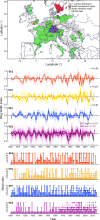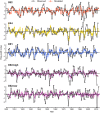Climatically controlled reproduction drives interannual growth variability in a temperate tree species
- PMID: 30230201
- PMCID: PMC6446945
- DOI: 10.1111/ele.13158
Climatically controlled reproduction drives interannual growth variability in a temperate tree species
Abstract
Climatically controlled allocation to reproduction is a key mechanism by which climate influences tree growth and may explain lagged correlations between climate and growth. We used continent-wide datasets of tree-ring chronologies and annual reproductive effort in Fagus sylvatica from 1901 to 2015 to characterise relationships between climate, reproduction and growth. Results highlight that variable allocation to reproduction is a key factor for growth in this species, and that high reproductive effort ('mast years') is associated with stem growth reduction. Additionally, high reproductive effort is associated with previous summer temperature, creating lagged climate effects on growth. Consequently, understanding growth variability in forest ecosystems requires the incorporation of reproduction, which can be highly variable. Our results suggest that future response of growth dynamics to climate change in this species will be strongly influenced by the response of reproduction.
Keywords: Fagus sylvatica; SEM; Dendrochronology; European beech; drought; forest growth; masting; path analysis; structural equation modelling; trade-off.
© 2018 The Authors Ecology Letters published by CNRS and John Wiley & Sons Ltd.
Figures






References
-
- Allen, R.B. , Millard, P. & Richardson, S.J. (2017). A resource centric view of climate and mast seeding in trees In: Progress in Botany (eds Cánovas F., Lüttge U. & Matyssek R.). Springer, Cham, pp. 233–268.
-
- Anderegg, W.R.L. , Schwalm, C. , Biondi, F. , Camarero, J.J. , Koch, G. , Litvak, M. et al (2015). Pervasive drought legacies in forest ecosystems and their implications for carbon cycle models. Science, 349, 528–532. - PubMed
-
- Ascoli, D. , Maringer, J. , Hacket‐Pain, A. , Conedera, M. , Drobyshev, I. , Motta, R. et al (2017a). Two centuries of masting data for European beech and Norway spruce across the European continent. Ecology, 98, 1473. - PubMed
Publication types
MeSH terms
Grants and funding
LinkOut - more resources
Full Text Sources
Other Literature Sources

